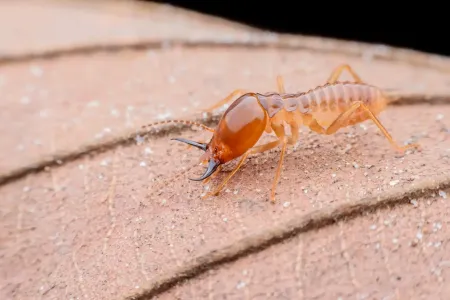Termites are wood-destroying insects that can cause serious damage to homes and buildings. Often called “silent destroyers,” termites feed on wood, paper, and other materials that contain cellulose. They can go unnoticed for months or even years, eating away at the structure of a property from the inside out.
About Termites
The most common type in the U.S. is the subterranean termite, which lives underground and enters homes through the soil. Other types include drywood termites, which live directly in the wood they eat, and dampwood termites, which prefer moist, decaying wood. In places like Arizona, the warm climate makes it easy for termites to stay active year-round.
Since termites often hide inside walls or underground, spotting them isn’t always easy. Here are some common signs of a termite problem:
- Mud tubes along the foundation or walls.
- Hollow-sounding wood when tapped.
- Tiny, discarded wings near doors, windows, or baseboards.
- Bubbling or uneven paint, which may look like water damage.
- Wood that looks blistered or damaged.
What Do Termites Look Like?
Termites are often mistaken for ants, but there are a few key differences to help you tell them apart. Depending on their role in the colony, termites can look slightly different, but they all share some common features. Here’s what to look for:

- Color: Most termites are pale, creamy white, or light brown. Swarmers (reproductive termites) can be darker, often brown or black.
- Size: Termites range from ⅛ inch to ½ inch long, depending on the type and caste.
- Body Shape: Unlike ants, termites have a straight waist with no pinch between body segments.
- Antennae: Termite antennae are straight or slightly curved, and ant antennae are bent.
- Wings: Swarmers have two pairs of wings that are equal in size and shape. These wings are longer than their bodies and fall off easily.
There are three main types of termites you might see:
- Workers: Soft-bodied, pale, and blind. They do all the damage.
- Soldiers: Similar to workers, but with large jaws and larger heads for defense.
- Swarmers (Alates): Winged termites that leave the colony to start new ones, often spotted during spring or after rain.
If you’re unsure whether you’ve seen termites or ants, it's best to have a pest professional take a look. Catching a termite infestation early can save you from serious damage later on.
What Are The Unique Characteristics of Termites?
Termites have several features and behaviors that make them stand out from other pests, and also make them a serious threat to homes. Here are some of their most unique characteristics:
- Silent Wood Destroyers: Termites eat wood from the inside out, often going unnoticed until the damage is severe. They can chew through wood 24/7 without rest.
- Live in Colonies: A single termite colony can contain thousands, even millions, of members, each with a specific role like workers, soldiers, or swarmers.
- Swarming Behavior: In spring or after a rain, winged termites (swarmers) leave the nest to start new colonies. These are often the first visible signs of a problem.
- Moisture Lovers: Most termites, especially subterranean species, are drawn to moist environments and need water to survive. That’s why they build mud tubes to stay protected and hydrated while moving between their nest and food source.
- Nocturnal Activity: Termites usually work and feed in the dark, avoiding light and open air. This stealthy behavior helps them stay hidden while causing damage.
- Ability to Digest Cellulose: Unlike most insects, termites can digest cellulose, a tough plant material found in wood, paper, and cardboard, thanks to special microbes in their guts.
What Are The Habits of Termites?
Termites are creatures of routine, and their habits are closely tied to their survival, reproduction, and the damage they cause. Knowing their typical behaviors can help you spot early signs of an infestation and better understand how they operate within your home.
Here’s a closer look at the common habits of termites:
- Constant Feeding: Termites eat nonstop, day and night, slowly breaking down wood, drywall, cardboard, and anything else made from plant fibers.
- Nesting Underground or Inside Walls: Most termites prefer dark, protected spaces. Subterranean termites build nests underground, while drywood termites live directly inside the wood they consume.
- Traveling Through Tunnels: To stay hidden and moist, termites build protective mud tubes made from soil and saliva. These help them safely move between their nest and food sources.
- Seasonal Swarming: During warm months, especially in spring or after a rain, swarmers (winged termites) fly out to start new colonies. These swarms are short-lived but are one of the few visible signs of a hidden infestation.
- Avoiding Light: Termites are highly sensitive to light and usually stay deep inside wood or soil. If you see them out in the open, it's likely a sign of a larger problem.
- Colony Cooperation: Termites work together to build, feed, and protect their colony. Workers gather food, soldiers defend the nest, and the queen lays eggs to grow the population.
What Are The Risks of a Termite Infestation?
A termite infestation isn’t just a nuisance; it can lead to serious and costly problems if left untreated. Because termites work quietly and out of sight, they often go undetected until the damage is extensive. Here are some of the main risks associated with termite activity:
- Structural Damage: Termites eat wood from the inside out, weakening support beams, flooring, walls, and even ceilings. Over time, this can lead to sagging floors, warped doors, and unsafe living conditions.
- Costly Repairs: Termite damage can be expensive to fix, and it’s rarely covered by homeowners' insurance. Catching an infestation early can help you avoid thousands of dollars in repairs.
- Decreased Property Value: Visible signs of termite damage, or a history of infestation, can lower your home's value and make it harder to sell.
- Damage Beyond Wood: While wood is their main target, termites can also damage drywall, insulation, paper products, and even furniture.
- Long-Term Infestations: Because colonies can survive for years, untreated termite problems can persist and worsen over time, leading to repeat damage and infestations.
- Hidden Activity: Termites are experts at staying out of sight. They often work behind walls, under floors, or inside foundations, making them hard to detect without a professional inspection.
If you think you might have termites, don’t wait. The longer they’re active, the more damage they can do. At Greenleaf Pest Control, we provide expert inspections and fast, effective treatments to stop termites in their tracks. Our termite exterminators in Phoenix service the Maricopa County area, so give us a call today to get started!






